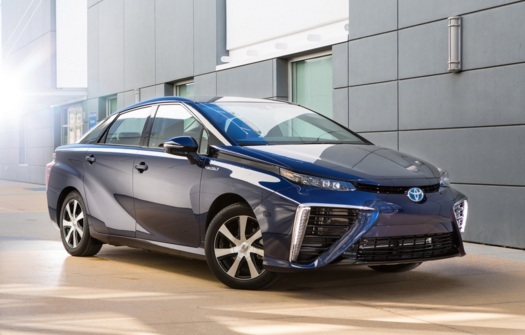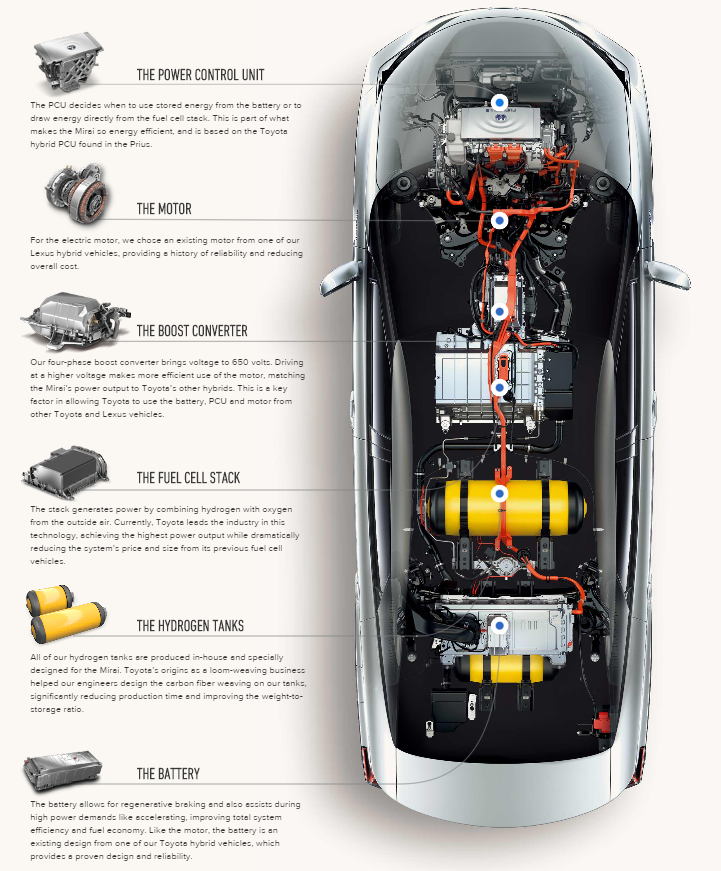Toyota Mirai with a hydrogen engine - the future is already in Europe
About the car from Toyota, powered by a hydrogen engine, they wrote about a year ago, at about the same time its sales were launched in Japan. However, the start of sales of Toyota Mirai (Mirai from Japanese translates to “future”) on the Continent (both in the old and the new) went almost unnoticed. Let's try to fix this moment and figure out how it works.
So, what Toyota offers us: a sedan car with an engine capacity of 153l.s, accelerating from 0 to 90km / h in 9.4sec. The maximum speed is electronically limited and is 170km / h. Very good, considering that the engine of the car is electric.
Appearance (photo from blog.toyota.co.uk )

No less interesting is what’s inside.
Block diagram of the car (from the Toyota website):

Hydrogen is stored in the tank, then it is mixed with outboard air, as a result of the reaction in the fuel cell, electricity is generated, from which (after conversion to the desired voltage) the AC motor works. Obviously, the main plus of such a car is an environmentally friendly "exhaust", every schoolchild knows that the reaction of hydrogen and oxygen will result in water vapor. Inside the car there is a container from which water must be periodically drained. The water seems to be quite clean, one of the authors of the reviews was not afraid to even drink it:

The power of the built-in generator is quite large, the car can even be used as a backup source of electricity with a capacity of up to 9 kW. Hydrogen itself is stored in a tank with a pressure of 10MPa, the refueling time is 3-5 minutes, the range declared by the manufacturer is up to 600km. According to the manufacturer, the carbon-reinforced tank is strong and safe enough to withstand accidents.
It's time to move on to the fun part: where is the car to refuel. Obviously, the prevalence of such cars is primarily limited by the presence of gas stations. And here everything is pretty sad for now. The first country where Mirai began to be sold was Japan. In addition to Japan and the USA, in Europe the car is delivered to 3 countries: Great Britain, Denmark and Germany (the first 5 cars were shipped in September 2015). There are currently 7 gas stations in Denmark, 10 in the USA, 18 in Germany and 4 in the UK. By the end of 2015, it is planned to build 50 gas stations in Germany, with an increase in this number to 400 by 2023.

An equally important step is the unification of gas stations: a single standard has been adopted, which allows, on the one hand, other manufacturers to make cars (and gas stations) with connectors of the same type, on the other hand, users of different models benefit from the appearance of a larger number of stations.
As for prices, in Germany a kilogram of hydrogen costs 9.5 €, refueling a full tank (4.7 kg capacity) will cost about 45 €. With a power reserve of 600 km, you can roughly calculate the cost of operation, which will be 7.5 € per 100 km. For comparison, the price of E10 gasoline is 1.3 €, i.e. 10 liters of gasoline will cost 13 €. In general, the cost of refueling is about the same.
The technology is certainly interesting. The main plus, which the manufacturer points to: full environmental friendliness, comparable to electric cars, and at the same time, fueling time, comparable to "ordinary" gasoline cars. The minus is also obvious: a deliberate complication of the design and a small number of gas stations.
Purely intuitive, I like the idea and concept of an electric car more: the battery and brushless motor make the car very simple, with a minimum of moving parts. Here we see a clearly complicated design with hypothetically unsafe components (everyone remembers Hindenburg?). On the other hand, we are unlikely to see technology that allows you to charge the battery in 5 minutes, so hydrogen cars will clearly occupy their niche where fast refueling is needed. Well, in general, I still hope to live up to the moment when the air in the cities becomes clean (although there are doubts, especially with regard to Russia), and a new type of environmentally friendly cars is another step towards this.
Finally, the price point. The price of Toyota Mirai is $ 58,325 in the US and 66,000 € in Europe. Not cheap, but on the other hand, it is quite comparable with other premium cars. In total, Toyota plans to produce 700 cars in 2015, and 2,000 units in 2016.
PS: If you are interested, the video (in English) and some links:
www.youtube.com/watch?v=hTmL5YPU0ek
ssl.toyota.com/mirai/fcv.html
blog.toyota.co.uk/mirai-launch-the -future-arrives-in-hamburg
europe.autonews.com/article/20151016/ANE/151019907/toyota-targets-mirai-fuel-cell-car-at-germany-uk
PPS: All the information collected above was found in open sources , 100% certainty is not guaranteed. If there are any inaccuracies, write, correct.
So, what Toyota offers us: a sedan car with an engine capacity of 153l.s, accelerating from 0 to 90km / h in 9.4sec. The maximum speed is electronically limited and is 170km / h. Very good, considering that the engine of the car is electric.
Appearance (photo from blog.toyota.co.uk )

No less interesting is what’s inside.
Design
Block diagram of the car (from the Toyota website):

Hydrogen is stored in the tank, then it is mixed with outboard air, as a result of the reaction in the fuel cell, electricity is generated, from which (after conversion to the desired voltage) the AC motor works. Obviously, the main plus of such a car is an environmentally friendly "exhaust", every schoolchild knows that the reaction of hydrogen and oxygen will result in water vapor. Inside the car there is a container from which water must be periodically drained. The water seems to be quite clean, one of the authors of the reviews was not afraid to even drink it:

The power of the built-in generator is quite large, the car can even be used as a backup source of electricity with a capacity of up to 9 kW. Hydrogen itself is stored in a tank with a pressure of 10MPa, the refueling time is 3-5 minutes, the range declared by the manufacturer is up to 600km. According to the manufacturer, the carbon-reinforced tank is strong and safe enough to withstand accidents.
Gas station
It's time to move on to the fun part: where is the car to refuel. Obviously, the prevalence of such cars is primarily limited by the presence of gas stations. And here everything is pretty sad for now. The first country where Mirai began to be sold was Japan. In addition to Japan and the USA, in Europe the car is delivered to 3 countries: Great Britain, Denmark and Germany (the first 5 cars were shipped in September 2015). There are currently 7 gas stations in Denmark, 10 in the USA, 18 in Germany and 4 in the UK. By the end of 2015, it is planned to build 50 gas stations in Germany, with an increase in this number to 400 by 2023.

An equally important step is the unification of gas stations: a single standard has been adopted, which allows, on the one hand, other manufacturers to make cars (and gas stations) with connectors of the same type, on the other hand, users of different models benefit from the appearance of a larger number of stations.
As for prices, in Germany a kilogram of hydrogen costs 9.5 €, refueling a full tank (4.7 kg capacity) will cost about 45 €. With a power reserve of 600 km, you can roughly calculate the cost of operation, which will be 7.5 € per 100 km. For comparison, the price of E10 gasoline is 1.3 €, i.e. 10 liters of gasoline will cost 13 €. In general, the cost of refueling is about the same.
conclusions
The technology is certainly interesting. The main plus, which the manufacturer points to: full environmental friendliness, comparable to electric cars, and at the same time, fueling time, comparable to "ordinary" gasoline cars. The minus is also obvious: a deliberate complication of the design and a small number of gas stations.
Purely intuitive, I like the idea and concept of an electric car more: the battery and brushless motor make the car very simple, with a minimum of moving parts. Here we see a clearly complicated design with hypothetically unsafe components (everyone remembers Hindenburg?). On the other hand, we are unlikely to see technology that allows you to charge the battery in 5 minutes, so hydrogen cars will clearly occupy their niche where fast refueling is needed. Well, in general, I still hope to live up to the moment when the air in the cities becomes clean (although there are doubts, especially with regard to Russia), and a new type of environmentally friendly cars is another step towards this.
Finally, the price point. The price of Toyota Mirai is $ 58,325 in the US and 66,000 € in Europe. Not cheap, but on the other hand, it is quite comparable with other premium cars. In total, Toyota plans to produce 700 cars in 2015, and 2,000 units in 2016.
PS: If you are interested, the video (in English) and some links:
www.youtube.com/watch?v=hTmL5YPU0ek
ssl.toyota.com/mirai/fcv.html
blog.toyota.co.uk/mirai-launch-the -future-arrives-in-hamburg
europe.autonews.com/article/20151016/ANE/151019907/toyota-targets-mirai-fuel-cell-car-at-germany-uk
PPS: All the information collected above was found in open sources , 100% certainty is not guaranteed. If there are any inaccuracies, write, correct.
